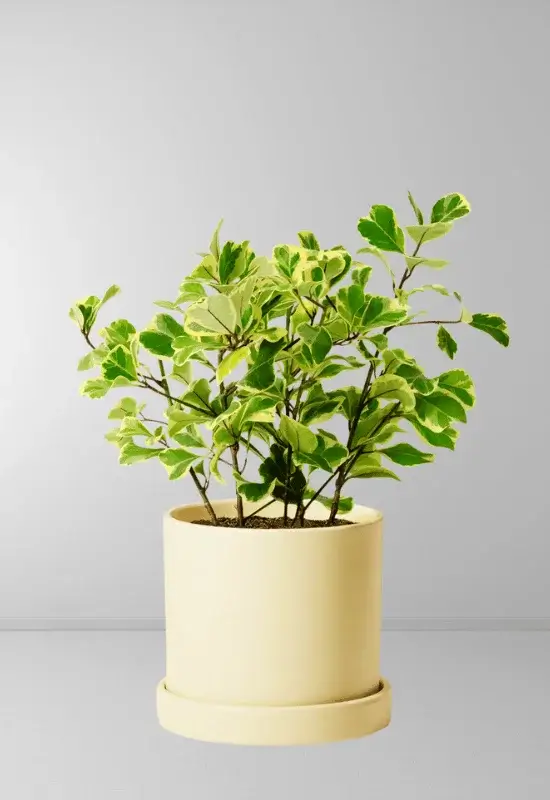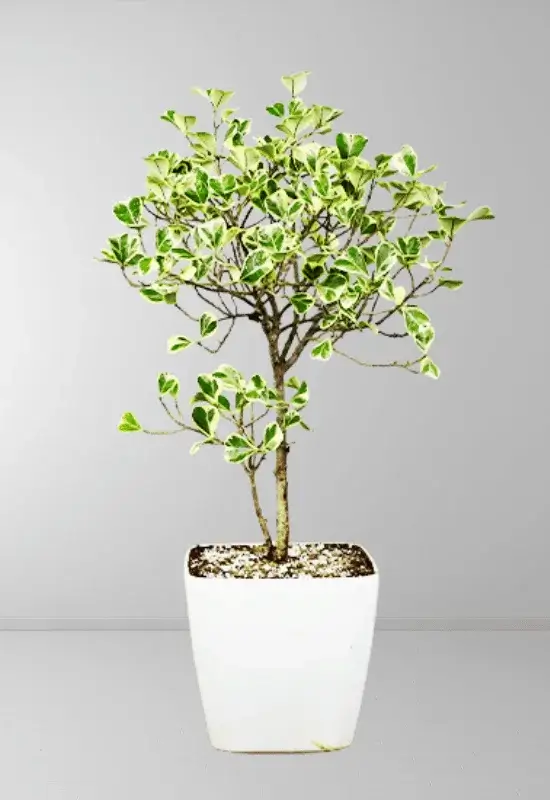Ficus Triangularis Variegata Plant Growth and Care Tips
Ficus Triangularis, or the Triangle Fig, is a captivating plant known for its unique triangular-shaped leaves. It belongs to the Ficus family and has gained popularity as an indoor and outdoor ornamental plant. This unique member of the Ficus family stands out for its distinctive triangular leaves, making it an eye-catching addition to any interior space.
| Category | Ficus Triangularis | Ficus Triangularis Variegata |
| Scientific Name | Ficus Triangularis | Ficus Triangularis Variegata |
| Common Names | Triangle Fig, Triangular Ficus | Variegated Triangle Fig |
| Physical Characteristics | Triangular leaves, medium size | Variegated leaves |
| Native Habitat | Tropical Regions | Tropical Regions |
| Use in Landscaping and Decoration | Indoor and Outdoor Ornamental | Popular for Indoor Decor |
| Light Requirements | Bright, Indirect Light | Bright, Indirect Light |
| Watering Guidelines | Moderate, Allow Soil to Dry | Moderate, Allow Soil to Dry |
| Temperature and Humidity | Warm and Humid | Warm and Humid |
| Soil Requirements | Well-draining, Rich Soil | Well-draining, Rich Soil |
| Pruning and Maintenance | Prune for Shape and Size | Prune for Shape and Size |
| Common Pests and Diseases | Aphids, Mealybugs, Leaf Drop | Aphids, Mealybugs, Leaf Drop |
Ficus Triangularis Variegata

Ficus Triangularis Variegata, often called the Variegated Triangle Fig, is a unique variety of Ficus Triangularis known for its eye-catching variegated leaves. These leaves feature attractive patterns of green and white, adding an extra layer of visual interest to the plant.
Physical attributes for Ficus Triangularis
This plant is characterized by medium-sized, glossy, and dark green leaves with a triangular shape. These leaves contribute an elegant touch to any setting, making it a popular choice for decoration.
Physical Attributes for Ficus Triangularis Variegata
The Variegated Triangle Fig stands out with its variegated leaves. These leaves showcase a captivating blend of green and white colors, making them stand out as ornamental plants.
Native Habitat
Ficus Triangularis

In its natural habitat, Ficus Triangularis thrives in tropical regions, where it enjoys warm temperatures and high humidity. Understanding its native conditions helps provide the proper care when cultivating it as a houseplant.
Ficus Triangularis Variegata

Like its non-variegated counterpart, the Variegated Triangle Fig also hails from tropical regions. It is well-suited for similar growing conditions, favoring warmth and humidity. However, when cultivated as an indoor plant, it typically remains much smaller, making it an ideal choice for home and office environments.
Use in landscaping and decoration.
Ficus Triangularis
Due to its eye-catching appearance, Ficus Triangularis is frequently used for indoor and outdoor landscaping. It can serve as an attractive focal point in garden patios or as a potted plant to enhance the beauty of interior spaces.
Ficus Triangularis Variegata
The Variegated Triangle Fig is a favored choice for indoor decoration. Its variegated leaves make it a prized ornamental plant, perfect for adding a touch of elegance and color to homes, offices, or other indoor spaces.
Light Requirements for Ficus Triangularis
Optimal Light Conditions
Ficus Triangularis Variegata thrives in bright, indirect light. It does best when placed near a north or east-facing window where it can receive filtered sunlight. It can tolerate some lower light conditions but may grow more slowly and have less vibrant variegation.
Avoiding Direct Sunlight
Avoid exposing your plant to direct sunlight, especially during the midday sun. Direct sunlight can scorch the leaves, causing damage. If you notice the leaves turning brown or developing spots, it’s a sign of sunburn.
Watering Guidelines for Ficus Triangularis
Watering Frequency
Water your Ficus Triangularis Variegata when the top inch (2.5 cm) of the soil feels dry to the touch. Use your finger to check the soil moisture. When watering, thoroughly moisten the soil but ensure that excess water drains from the pot. Empty the saucer beneath the pot to prevent the plant from sitting in standing water.
Soil Moisture Levels
Aim for consistently moist but not waterlogged soil. Overwatering can lead to root rot, while underwatering can cause the plant to wilt and drop leaves. Adjust the watering frequency based on the specific conditions in your home, considering factors like humidity and temperature.
Temperature and Humidity
Ideal Temperature Range
Ficus Triangularis Variegata prefers a warm environment. The ideal temperature range for this plant is between 65-75°F (18-24°C). Avoid exposing it to cold drafts or sudden temperature fluctuations, as this can stress the plant.
Humidity Preferences
These plants thrive in high humidity levels. Aim to maintain humidity levels of around 50% or higher. You can achieve this by misting the plant regularly, using a humidity tray, or placing a small humidifier nearby. In dry indoor environments, maintaining proper humidity is crucial for preventing issues like leaf drop.
Soil Requirements
Soil Type and Composition
Ficus Triangularis Variegata thrives in well-draining, rich potting soil. A suitable mix can include a combination of regular potting soil and perlite or sand to enhance drainage. Organic matter in the soil helps retain moisture without allowing it to become waterlogged.
Repotting Needs
Repot your plant every 2-3 years or when you notice it becoming root-bound. Choose a slightly larger pot with good drainage holes. Repotting allows the plant to have fresh soil and more space for root growth. Spring is often the best time for repotting as the plant begins its active growing season.
Pruning and Maintenance
Trimming for Shape and Size
Regular pruning is essential for maintaining the desired shape and size of your Ficus Triangularis Variegata. You can prune to encourage bushier growth or remove leggy or overgrown branches. Use clean, sharp pruning shears or scissors to make clean cuts, and avoid removing more than one-third of the plant’s growth at a time.
Dealing with Yellow Leaves
Yellowing leaves can signify various issues, including overwatering, underwatering, or stress from environmental changes. When you notice yellow leaves, carefully inspect the plant’s soil moisture and adjust your watering accordingly. Remove yellowed leaves with clean pruning shears to improve the plant’s appearance and health.
Pests and Diseases
Common Pests
Look for common pests such as aphids and mealybugs, which can infest Ficus Triangularis Variegata. If you notice these pests, gently wipe them off the leaves with a damp cloth or use insecticidal soap to treat the plant. Isolating the affected plant can help prevent the pests from spreading to other plants.
Disease Prevention
To prevent diseases, avoid overwatering and ensure good air circulation around the plant. Ensure the plant is not exposed to drafts or extreme temperature fluctuations, as stress can make it more susceptible to disease. If you notice any signs of fungal or bacterial issues, such as leaf spots or mold, promptly isolate the affected plant and treat it with appropriate fungicides or bactericides.
Common issues and solutions
| Common Issues | Solutions |
| Yellowing Leaves | 1. Check soil moisture and adjust watering as needed. |
| 2. Prune and remove yellowed leaves for improved aesthetics. | |
| 3. Ensure proper humidity levels and stable environmental conditions. | |
| 4. Inspect for pests and treat if necessary. | |
| Leaf Drop | 1. Maintain consistent temperature and avoid drafts. |
| 2. Ensure adequate humidity levels. | |
| 3. Gradually acclimate the plant to environmental changes. | |
| 4. Avoid sudden changes in lighting conditions. | |
| 5. Inspect for pests and treat if present. | |
| Pest Infestations(e.g., aphids, mealybugs) | 1. Physically remove pests with a damp cloth or cotton swab. |
| 2. Use insecticidal soap or neem oil for more severe infestations. | |
| 3. Isolate the affected plant to prevent the spread of pests. | |
| 4. Regularly inspect nearby plants for signs of infestation. | |
| Fungal or Bacterial Issues | 1. Improve air circulation around the plant |
| (e.g., leaf spots, mold) | 2. Ensure proper soil drainage and avoid overwatering. |
| 3. Isolate the affected plant to prevent the spread of disease. | |
| 4. Use appropriate fungicides or bactericides as directed. | |
| 5. Prune and remove affected leaves or branches. |
Final Words
Ficus Triangularis and Ficus Triangularis Variegata are captivating plants that can add a touch of elegance and natural beauty to your indoor or outdoor spaces. Understanding their unique characteristics and providing the right care is essential for their well-being.
Also Read: Ficus Triangularis Tree
Frequently Asked Questions
Q1: What are the key differences between Ficus Triangularis and Ficus Triangularis Variegata?
The main difference lies in their foliage. Ficus Triangularis has dark green, triangular-shaped leaves, while Ficus Triangularis Variegata has variegated leaves with striking patterns of green and white. The variegated variety is prized for its unique appearance.
Q2: What’s the best location for my Ficus Triangularis Variegata indoors?
Place your Ficus plant in a spot with bright, indirect sunlight. Avoid direct sunlight, as it can scorch the leaves. A north or east-facing window is often a suitable location.
Q3: How often should I water my Ficus Triangularis Variegata?
Water your plant when the top inch (2.5 cm) of the soil feels dry to the touch. Ensure proper drainage, and avoid overwatering, as it can lead to root rot.
Q4: Why are the leaves of my Ficus Triangularis Variegata turning yellow?
Yellowing leaves can be a sign of overwatering, underwatering, or environmental stress. Check the soil moisture, adjust your watering routine if necessary, and ensure stable environmental conditions.
Q5: How can I propagate my Ficus Triangularis Variegata?
Ficus Triangularis Variegata can be propagated through stem cuttings. Take a healthy cutting with a few leaves, let it callus for a day or two, then plant it in a well-draining soil mix. Keep the soil consistently moist until roots develop.
Q6: Is Ficus Triangularis Variegata prone to pests and diseases?
Yes, like many indoor plants, Ficus Triangularis Variegata can be susceptible to common pests such as aphids and mealybugs. Regularly inspect your plant and take action if you notice any infestations. Additionally, ensure good airflow to prevent fungal or bacterial issues.
Q7: When is the best time to repot my Ficus Triangularis Variegata?
Repot your plant Variegata every 2-3 years or when it becomes root-bound. Spring is typically the ideal time for repotting, as it aligns with the plant’s active growing season.
Q8: Can I place my Ficus Triangularis Variegata outdoors during the summer?
Yes, you can place your plant outdoors in a shaded or partially shaded area during the summer months, but avoid exposing it to direct sunlight and protect it from strong winds.



